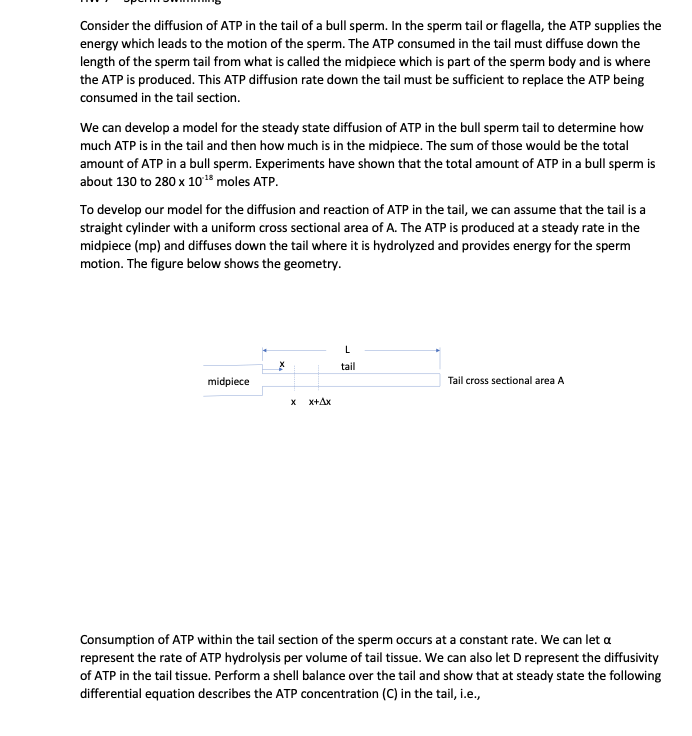Home /
Expert Answers /
Chemical Engineering /
consider-the-diffusion-of-atp-in-the-tail-of-a-bull-sperm-in-the-sperm-tail-or-flagella-the-atp-pa757
(Solved): Consider the diffusion of ATP in the tail of a bull sperm. In the sperm tail or flagella, the ATP ...
Consider the diffusion of ATP in the tail of a bull sperm. In the sperm tail or flagella, the ATP supplies the energy which leads to the motion of the sperm. The ATP consumed in the tail must diffuse down the length of the sperm tail from what is called the midpiece which is part of the sperm body and is where the ATP is produced. This ATP diffusion rate down the tail must be sufficient to replace the ATP being consumed in the tail section. We can develop a model for the steady state diffusion of ATP in the bull sperm tail to determine how much ATP is in the tail and then how much is in the midpiece. The sum of those would be the total amount of ATP in a bull sperm. Experiments have shown that the total amount of ATP in a bull sperm is about 130 to \( 280 \times 10^{-18} \) moles ATP. To develop our model for the diffusion and reaction of ATP in the tail, we can assume that the tail is a straight cylinder with a uniform cross sectional area of A. The ATP is produced at a steady rate in the midpiece (mp) and diffuses down the tail where it is hydrolyzed and provides energy for the sperm motion. The figure below shows the geometry. Consumption of ATP within the tail section of the sperm occurs at a constant rate. We can let \( \alpha \) represent the rate of ATP hydrolysis per volume of tail tissue. We can also let D represent the diffusivity of ATP in the tail tissue. Perform a shell balance over the tail and show that at steady state the following differential equation describes the ATP concentration (C) in the tail, i.e.,
\[ \frac{d^{2} C}{d x^{2}}-\left(\frac{k}{D A L}\right)=0 \] where \( k \) is the ATP consumption rate on the basis of a bull sperm tail, i.e., \( k=\alpha \mathrm{AL} \). The boundary conditions are that at the end of the tail, i.e., at \( \mathrm{x}=\mathrm{L} \), we can assume that all of the ATP in the tail has been consumed and that no ATP diffuses out from the tail tip. Hence, we have: \[ \begin{array}{l} \mathrm{BC} 1: \mathrm{x}=\mathrm{L}, \mathrm{C}=0 \\ \mathrm{BC} 2: \mathrm{x}=\mathrm{L}, \frac{d c}{d x}=0 \end{array} \] Next, integrate the above differential equation for \( \mathrm{C} \) and use the \( \mathrm{BC} \) 's and show that \( \mathrm{C}(\mathrm{x}) \) is given by: \[ C(x)=\left(\frac{k}{2 D A L}\right) x^{2}-\left(\frac{k}{D A}\right) x+\left(\frac{k L}{2 D A}\right) \] Then, show that the total amount of ATP in the tail is given by: \[ A T P_{\text {tail }}=\frac{k L^{2}}{6 D} \] We can obtain the concentration of ATP in the midpiece by finding \( \mathrm{C}(\mathrm{x}) \) at \( \mathrm{x}=0 \) and assuming the ATP is uniformly at this concentration in the midpiece. Therefore, show that \[ C(0)=\frac{k L}{2 D A} \] The amount of ATP in the midpiece is then \( \mathrm{C}(0) \) times the volume of the midpiece, \( \mathrm{V}_{\mathrm{mp}} \). So, show that the total amount of ATP in the bull sperm is then given by: \[ A T P_{\text {total }}=A T P_{\text {tail }}+A T P_{\text {midpiece }}=\frac{k L}{2 D}\left(\frac{L}{3}+\frac{V_{m p}}{A}\right) \]

![\[
\frac{d^{2} C}{d x^{2}}-\left(\frac{k}{D A L}\right)=0
\]
where \( k \) is the ATP consumption rate on the basis of a bull](https://media.cheggcdn.com/media/0f7/0f7babe5-89de-4d34-977f-6ee6cab97bef/phpKmQSqm)